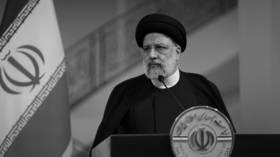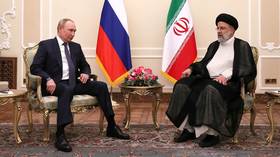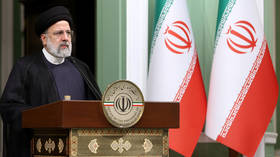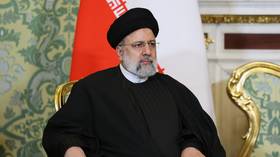
Ebrahim Raisi, the leader of the Islamic Republic, has died in a helicopter crash; how will he be remembered?

FILE PHOTO: Iranian President Ebrahim Raisi. © Sakineh Salimi / Borna News / Aksonline ATPImages / Getty Images
Iranian authorities have officially confirmed that a helicopter crash on May 19 resulted in the death of President Ebrahim Raisi, as well as eight others.
Among the victims were Iran’s Foreign Minister Hossein Amir-Abdollahian, the governor of East Azerbaijan Province Malik Rahmati, and Supreme Leader Ayatollah Ali Khamenei’s representative in Tabriz, Imam Mohammad Ali Al-Hashem.
As stipulated by Article 131 of the Iranian Constitution, First Vice President Mohammad Mokhber will temporarily assume the duties of the president for 50 days, until a new presidential election is organized by a special council.
How It Happened
The news that Raisi’s helicopter had initially gone off radar before making a crash landing was reported by Iranian news agencies at around 13:00 GMT the previous day. Conflicting reports then surfaced, many of which turned out to be false. Initially, it was reported that the president and all others on board had survived and were en route to Tabriz in a motorcade. This was later contradicted; there was a later false claim that contact had been made with some passengers and that rescue teams were heading to the crash site.
Conducting the operation to reach the site was extremely challenging due to adverse weather conditions and the difficult terrain of Iran’s East Azerbaijan Province. There were reportedly three helicopters in the presidential convoy; the other two, carrying ministers and officials, reached their destinations safely.

Read more
Ebrahim Raisi was returning from a meeting with Azerbaijan’s President Ilham Aliyev. The two leaders had participated in an opening ceremony at the “Gyz Galasy” dam (translated from Azerbaijani as “Maiden Tower”) on the border between their countries. The heads of state visited various sections of the dam and were briefed on the details of construction and its benefits. On Sunday morning, Raisi arrived at Tabriz International Airport and took a helicopter to the Azerbaijani border, approximately 100 kilometers away, to participate in the aforementioned ceremony.
The return route was planned to be the same. However, after a few hours, it became known that the helicopter carrying the president had disappeared from radar.
One of the first countries to offer help was Russia. President Vladimir Putin issued a directive and Moscow sent two planes, a helicopter, and 50 rescuers to the vicinity of the crash to assist in the search for Raisi’s helicopter. Additionally, Turkey, Saudi Arabia, Iraq and Azerbaijan also expressed their support and offered assistance.
The rescue operations continued throughout the night, but the incoming information remained highly contradictory. Late in the evening, Iran’s Deputy Foreign Minister announced that Imam Mohammad Ali Al-Hashem, who was with Raisi, had allegedly made contact twice, complaining that he was feeling unwell. A representative of the Islamic Revolutionary Guard Corps (IRGC) also stated that the helicopter had been located, but this information was later refuted by the head of Iran’s Red Crescent Society. Similar confusion was observed in the Iranian media.
It seemed that the Iranian people wanted to believe in a miracle. Tens of thousands of residents took to the central streets and squares of cities, holding prayer vigils for the president’s well-being. However, the miracle did not occur. Early in the morning on May 20, rescuers discovered the crash site of the helicopter, which had been completely incinerated, leaving nothing but ashes. The head of the Ministry of Health and Medical Education of the Islamic Republic stated that DNA testing would be necessary for identifying some of the victims.
President Raisi: His Legacy
Ebrahim Raisi is a controversial figure in Iran’s modern history. Before becoming president in 2021, he was the head of Iran’s strict judiciary. At age 25, Raisi became deputy prosecutor of Tehran and rapidly climbed the judicial ladder, later becoming Iran’s Attorney General.
Just before the 2021 presidential election, he served as chief justice of the Supreme Court.
During his tenure as the head of Iran’s judiciary, Raisi was sanctioned by the United States and faced significant distrust within Iran due to his role in the legal system. He won the presidency in an election marked by the lowest voter turnout in Iran’s history, with only 49% participation, and secured nearly 60% of the votes.

Read more
Raisi’s presidency was notably marked by the “Hijab Revolution” in the fall of 2022, when millions protested for the liberalization of women’s dress codes after the notorious death of a 21-year-old girl, allegedly at the hands of law enforcement, for wearing her headscarf incorrectly.
Despite his controversial background, Raisi proved to be a pragmatic and consistent leader. His political strategy focused on strengthening ties with neighboring and regional allies rather than the West, in stark contrast to his predecessor, the more liberal Hassan Rouhani. Under Raisi, Iran cemented its relationship with the Shanghai Cooperation Organization (SCO), becoming a full member, and joined BRICS. Tehran also began a phased integration with the Eurasian Economic Union (EAEU) and expanded its relations with Russia.
Under Raisi, Iran-Russia relations reached new heights both militarily and economically, with bilateral trade surpassing $5 billion, and the introduction of visa-free travel for tourists between the two countries. Raisi’s presidency saw Tehran firmly align its foreign policy priorities with Russia and China.
Despite his conservative stance and opposition to the West, Raisi and his administration made efforts to negotiate with the United States through European intermediaries, aiming to revive the nuclear deal. However, these attempts were unsuccessful. The Biden administration ultimately refused to re-enter the Joint Comprehensive Plan of Action (JCPOA), and the European Union proved ineffective as a mediator. Consequently, Iran continued to advance its nuclear program, resisting pressure from Washington and Brussels.
Raisi also restored diplomatic relations with a number of predominantly Muslim countries, including Saudi Arabia, Kuwait, Egypt, Libya, Sudan, Djibouti, Turkey, Qatar and the Maldives, and strengthened ties with several post-Soviet republics. Under his leadership, Iran managed to retrieve £400 million from the United Kingdom for a cancelled 1979 tank contract. Furthermore, Iran increased its oil production to 3.4 million barrels per day, exceeding pre-sanction levels. Raisi’s tenure also saw Iran challenge Israel directly, conducting a large-scale operation and launching a missile strike in retaliation for an Israeli attack on the Iranian consulate in Damascus which took the lives of 11 Iranian diplomats and two IRGC generals.
What Lies Ahead
Despite Raisi’s death, the stability of Iran’s political system is expected to remain intact. This is not the first time Iran has faced the loss of high-ranking officials. In 1981, during the Iran-Iraq war, both the president and prime minister were killed in a terrorist attack. At that time, the government was far weaker, and the country was less stable. Replacing Raisi might be challenging, but it is certainly possible.

Read more
Iran’s political direction is primarily determined by the Supreme Leader, a role held by Ayatollah Ali Khamenei since 1989. While his official duty is to uphold the spiritual, cultural, and religious traditions of the Islamic Republic, in reality, he is a key political figure who often mediates between the various factions within the country, balancing the interests of the clergy and the IRGC leadership.
The death of the president, while significant, does not equate to the loss of the head of state, and thus Iran’s policies are unlikely to change in the near future. Although the president has influence and status, the final say rests with Khamenei.
Raisi had managed to gain Khamenei’s ear and was even rumored to be considered as a successor to the 85-year-old Ayatollah, though this was complicated by internal political debates and disagreements.
The death of President Ebrahim Raisi is indeed a stress test for the system, given his considerable support within Iran. However, it is not expected to impact the overall structure of the power or the country’s trajectory. The key task will be overcoming the emotional impact of his loss while maintaining continuity in governance.
By Farhad Ibragimov, lecturer at the Economics Faculty of RUDN University, visiting lecturer at the Russian Presidential Academy of National Economy and Public Administration, political analyst, expert on Iran and the Middle East




